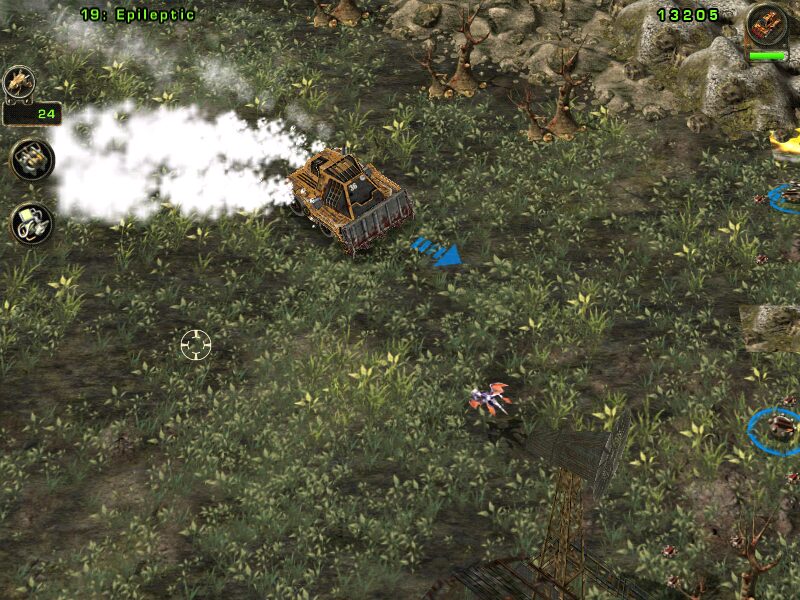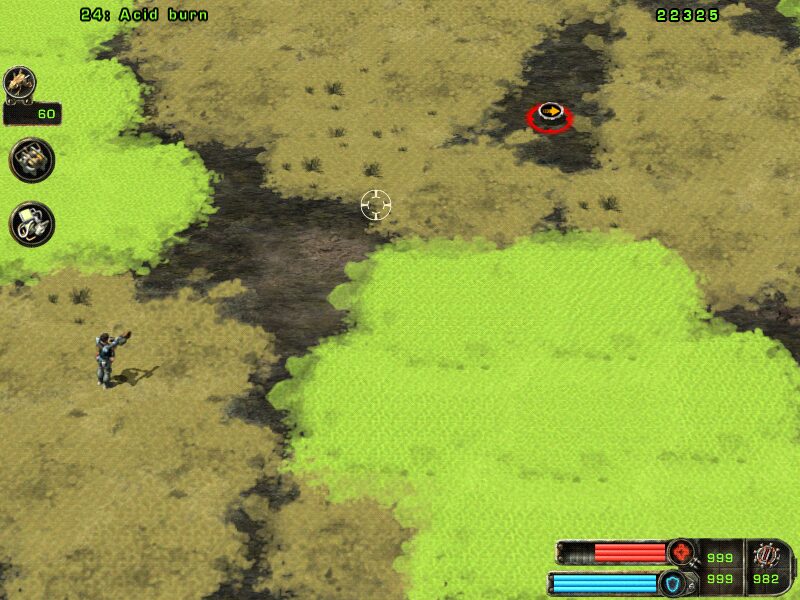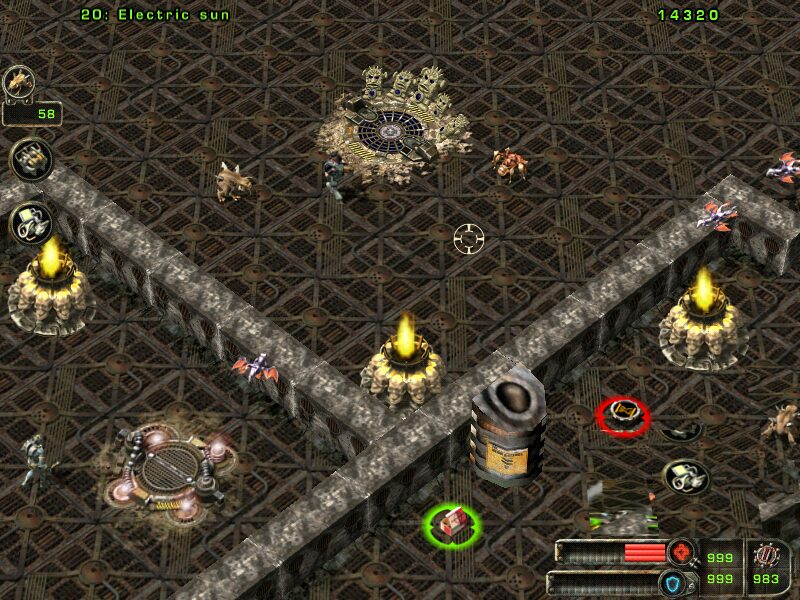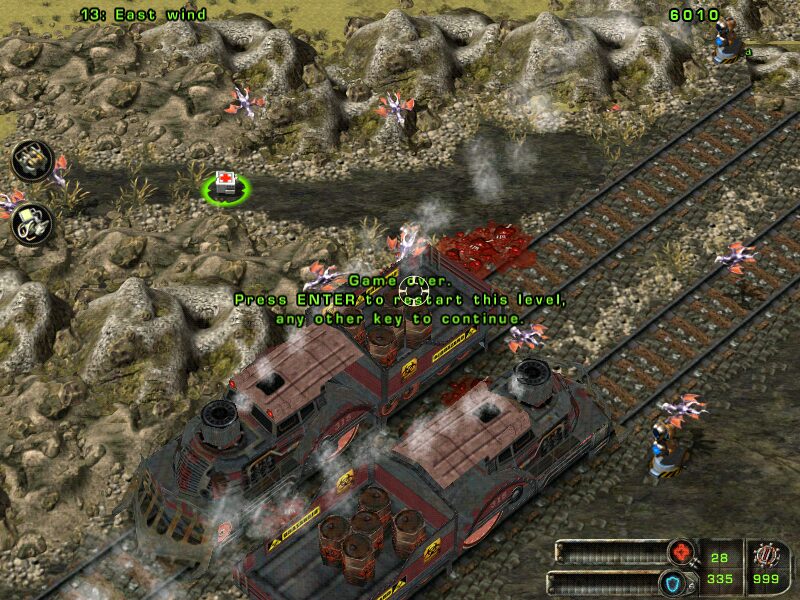Retro Replay Review
Gameplay
After the End places you in the boots of a stranded patrol officer on the ruined planet Rydon 7, and from the very first moment the game’s isometric shooter mechanics make their presence felt. You’ll navigate dense forests, abandoned research labs, shrines dripping with eerie ambience, and even molten lava fields. Movement is tight and responsive, offering a satisfying sense of control as you dodge fireballs, weave through ambushes, and line up precise shots. The pacing strikes a good balance between frantic action and moments of tactical retreat to regroup and reap the spoils of your latest kills.
The arsenal in After the End is a highlight: sixteen varied weapons from flamethrowers and shotguns to explosives and deployable mines. Each firearm has its own distinct feel and situational use—shotguns deliver devastating close-range power, while sniper-like railguns reward patience and accurate aim. You’ll unlock vehicles on occasion, such as hover-rafts or armored buggies, which add a dynamic twist to segments where you can simply run over scores of weaker foes before corking off into the next area.
An RPG-lite progression system keeps you invested: your character “levels up” with each monster you vanquish, granting points you can allocate to increase your life bar, shorten reload times, or boost weapon damage. This creates a steady sense of growth that’s especially welcome in the later Survival mode, where waves of creatures bear down on you relentlessly. Campaign, Firing Range, and Survival modes each cater to different playstyles: newcomers can learn their weapons and mechanics safely, while veterans can test endurance and high-score strategies online through built-in leaderboards.
Graphics
Visually, After the End delivers a solid isometric presentation that harks back to classic top-down shooters but with contemporary color palettes and effects. The environmental textures feel richly detailed, from the moss-covered lab walls and flickering corridor lights to the glistening sheen of flowing lava. Each themed area boasts unique set pieces—ancient totems hidden in woods, crucible chambers in the labs—giving a strong sense of progression as you push deeper into the planet’s mysteries.
Enemy design shows off a creative bestiary, ranging from slithering insectoids to hulking rock-beasts that erupt in showers of glowing minerals when defeated. Animations are smooth, with satisfying recoil on higher-tier weapons and convincing particle effects when explosives detonate. The game also features an optional “gore toggle” for blood effects, catering to players who prefer a more family-friendly experience without sacrificing the visceral thrill of combat.
Lighting and particle effects further enhance the mood. In darker environments, your muzzle flash casts dramatic shadows, while bioluminescent mushrooms or alien crystals add pops of color in the gloom. Though the isometric viewpoint occasionally obscures smaller enemies behind scenery, quick camera panning and transparent wall mechanics mitigate frustration, keeping the action clear and readable even in tight quarters.
Story
The narrative of After the End is straightforward but engaging: you receive a distress signal from Rydon 7’s research base, only to have your patrol ship shot down upon atmospheric entry. Stranded and with your comms down, you must gather the stolen fragments of your vessel scattered across hostile environments. This simple premise sets a purposeful tone from the outset—you’re not on a leisurely vacation, you’re fighting to regain mobility and uncover the culprits behind the attack.
Throughout the campaign, bits of lore and environmental storytelling enrich the backdrop. You’ll discover data logs, charred lab notebooks, and audio transmissions that shed light on experiments gone awry and the corporate interests vying for the planet’s resources. While dialogue is minimal, each recovered clue propels your motivations and teases deeper conspiracies: Who sabotaged the base? What unspeakable research drove these horrors?
The story’s strength lies in its organic integration with gameplay. You aren’t simply blasting monsters for the sake of it—you’re uncovering why these creatures exist and how they’re connected to your missing ship parts. This sense of investigation and discovery keeps you pushing forward, even through the toughest Survival mode waves, because there’s always the next clue waiting just beyond the next lab door.
Overall Experience
After the End excels at blending fast-paced shooter mechanics with light role-playing elements, delivering a compelling blend of action, exploration, and character progression. The variety of weapons and environments ensures that no two levels feel identical, and the ability to swap loadouts on the fly invites creative approaches to each challenge. Whether you prefer to charge headlong with a flamethrower or pick off targets carefully with long-range plasma rifles, the game accommodates your style.
Replayability is strong, thanks to Survival mode’s escalating difficulty, global leaderboards, and the optional Firing Range tutorial that doubles as a training ground for mastering every weapon. Hardcore players can aim for perfect runs, minimal-damage campaigns, or speed-run records, while casual gamers can simply blast through the story at their own pace and enjoy the spectacle.
While a deeper narrative could have further raised the stakes, After the End remains an engaging experience from crash site to final boss arena. Its intuitive controls, varied enemy roster, and thoughtful progression system make it an easy recommendation for fans of isometric action shooters. If you’re seeking a game that balances nonstop combat with exploration and light RPG elements, Rydon 7’s wasteland is ready to challenge you—and you might just have a blast surviving it.
 Retro Replay Retro Replay gaming reviews, news, emulation, geek stuff and more!
Retro Replay Retro Replay gaming reviews, news, emulation, geek stuff and more!









Reviews
There are no reviews yet.